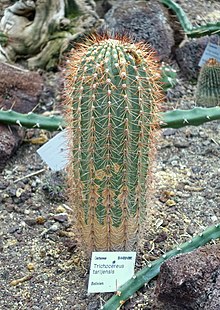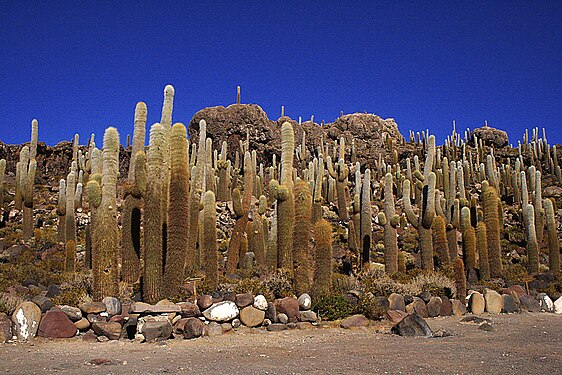Soehrensia tarijensis
| Soehrensia tarijensis | |
|---|---|

| |
| Scientific classification | |
| Kingdom: | Plantae |
| Clade: | Tracheophytes |
| Clade: | Angiosperms |
| Clade: | Eudicots |
| Order: | Caryophyllales |
| Family: | Cactaceae |
| Subfamily: | Cactoideae |
| Genus: | Soehrensia |
| Species: | S. tarijensis
|
| Binomial name | |
| Soehrensia tarijensis (Vaupel) Schlumpb.
| |
| Synonyms | |
| |
Soehrensia tarijensis, is a species of Soehrensia, in the cactus family. It is native to Bolivia and northwestern Argentina.[2]
Description[edit]
Soehrensia tarijensis initially grows individually, later becoming a shrub with few side branches and reaching heights of growth of up to 5 meters. The strong, cylindrical, dark green shoots reach a diameter of up to 35 centimeters. There are 15 to 21 ribs. The large, clear areoles located on them are covered with gray felt and are close together. Light brown to whitish, unequal thorns emerges from them. The stiff, stinging spines are slightly curved and thickened at their base. They have a length 1 of 8 centimeters. One to four central spines and 50 or more radial spines are formed.
The funnel-shaped flowers are red to pink to creamy white. They appear near the top of the shoot. The flowers are up to 12 centimeters long and have a diameter of 9 centimeters. The egg-shaped, green fruits are 3.5 to 5 centimeters long and have a diameter of 2 to 3 centimeters.[3]
Distribution[edit]
Soehrensia tarijensis is widespread in the southwest and south of Bolivia and the Argentine province of Jujuy in the Andes at altitudes of 3000 to 4500 meters.
-
Habitat in Jujuy, Argentina
-
Habitat in Salar de Uyuni, Bolivia
Taxonomy[edit]
The first description as Cereus tarijensis by Friedrich Vaupel was published in 1916.[4] The specific epithet tarijensis refers to the occurrence of the species near Tarija in the Bolivian Department of Tarija. Spanish common names are "Poco", "Poco-Poco", "Achuma" and "Cardón". The fruits are called "Pasacana". It was formerly a species in Echinopsis.[5] Boris O. Schlumpberger placed the species in the genus Soehrensia in 2012. Further nomenclatural synonyms are Trichocereus tarijensis (Vaupel) Werderm. (1940), Helianthocereus tarijensis (Vaupel) Backeb. (1955), Echinopsis tarijensis (Vaupel) H.Friedrich & G.D.Rowley (1974), Lobivia formosa subsp. tarijensis (Vaupel) Rausch (1975) and Lobivia formosa var. tarijensis (Vaupel) Rausch (1987).
Subspecies[edit]
It has 2 accepted subspecies;[2]
References[edit]
- ^ "The IUCN Red List of Threatened Species". IUCN Red List of Threatened Species. 2012-09-17. Retrieved 2023-08-27.
- ^ a b "Soehrensia tarijensis (Vaupel) Schlumpb. | Plants of the World Online | Kew Science". Plants of the World Online. Retrieved 29 October 2022.
- ^ "The IUCN Red List of Threatened Species". IUCN Red List of Threatened Species: 245–246. 2012-09-17. Retrieved 2023-09-22.
- ^ "Monatsschrift für Kakteenkunde". J. Neumann. 1915. Retrieved 2023-09-22.
- ^ "Echinopsis tarijensis". Tropicos. Retrieved 2019-08-22.
External links[edit]
 Media related to Soehrensia tarijensis at Wikimedia Commons
Media related to Soehrensia tarijensis at Wikimedia Commons Data related to Soehrensia tarijensis at Wikispecies
Data related to Soehrensia tarijensis at Wikispecies




